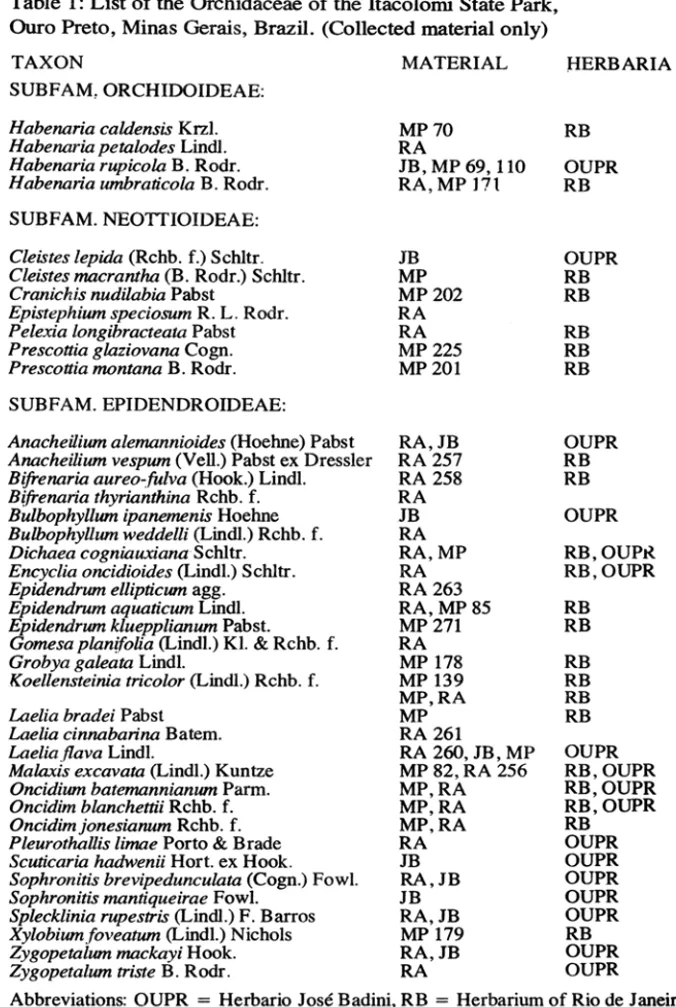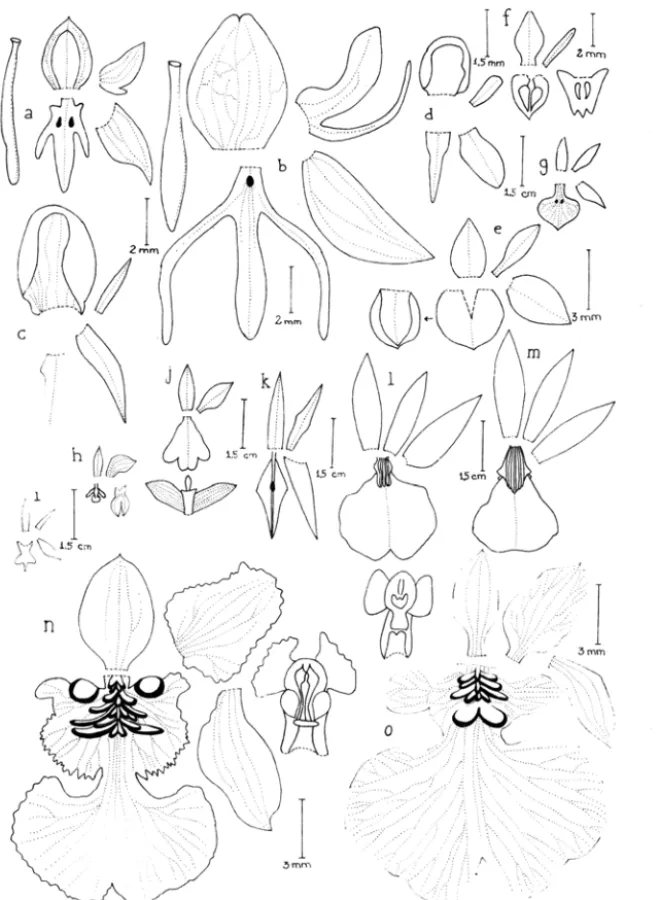THE ORCHIDACEAE OF ITACOWMI STATE PARK
IN MINAS GERAIS, BRAZIL
Ruy José Válka Alves1 Recebido em 158-89 Aceito em 155 -90
RESUMO - Este traba1ho faz uma parcial comparação de duas épocas da flÓruIa de Orchidaceae do Parque Estadual do ltacolomi em Ouro Preto, MG. A primeira é representada por coletas anteriores a 1980, e a segunda pelas coletas dos últimos cinco anos. Análises florais documentam as coletas recentes.
Palavras-chave: Brasil, Florística, Minas Gerais, Orchidaceae, Ouro Preto.
ABSTRACT - This paper compares the partial Orchidaceae floras of Itacolomi State Park in Ouro Preto, Minas Gerais, Brazil, in two different periods_ The flTSt is represented by a1l colections prior to 1980, while the second comprises those of the past five years. Floral analyses document the recent collections.
Key words: Floristic survey, Orchidaceae, Ouro Preto, Minas Gerais, Brazil.
Introduction
During the floristic survey of ltacolomi State Park above Ouro Preto in Minas Gerais, Brazil, (Figura 1), Marcos Peron had asked me to identify the collected orchid specimens and to rnake a list of species. To his specimens, I added those which I had collected during five recent expeditions. All speci-mens were then docurnented by slides for identification by the method of flo-ral ana1ysis (Alves 1989a).
ltacolomi State Park is a doi omite - quartzite forrnation reaching 1772 m .s.m. and is covered mainly by "cerrado" and "campo rupestre" types of vegetation. Saxicolous and epiphytic plants play an importaot role in these forrnations , which are dominated by a rather continuous herbaceous layer with sparse shrubs. Denser stands of woody plants occur only in places where the geomorphology permits accurnulation of deeper and moister substrates (Le. ventaroles etc.), and protects the locations from strong winds. Another factor which profoundly affects their occurence is anthropic management (frequent
66 Alves
-tires, overgrazing by eattle, etc.) The Orchidaceae that survive the eombina-tion of the above -meneombina-tioned factors are of primary interest to my studies, and have been so for years.
Material and Methods
The species of Orehidaceae from ltaeolomi State Park were studied both in the field and in herbaria. Flowered specimens were dried on standard hema-rium sheets, part of their flowers having been fixed direetly in 70% ethanol
solution. Some sterile especimens were indueed to flower in eultivation, and a few remain sterile to date. The environmental faetors were recorded for most species. In order to avoid further reduetion of the populations, many species were left in the field, (only two to four flowers were eollected).
The identifieation of speeimens was done aeeording to the floral analysis method (Alves 1989a), or simply by eomparison when posssible. Not all dru-ghtshere in are thus true analyses (Figure 2g-k; 3g-k were drawn direetly from the slide.) Transparent acetate slides of.24 x 36 mm were used for most spe-cies. For the Epidendrum ellipticum sp. agg., only the labellum struetures are necessary. For some genera other taxonomieally relevant struetures were draw, sueh as the eolumn in Oncidium and spurs in Habenarla (Figure 2-3). Despite the newer classifieation systems proposed, I follow that of Garay sueh as found in Pabst & Dungs (1975, 1977), mainly due to its wide use in herba-ria. Some valuable data, sueh on Habenaria itacolumia was taken from Hoeh-ne (1940).
'. OURO PRETO
MAIN COLLECTION AREA
'400
68 Alves Results
This survey is preliminary in the sense that other species may be refound or discovered in the referred biota. The distribution of these species and their dependence upon the existing plant associations in the park is still being stu-died, but the data herein can already be useful for researchers concerned with
the local flora, vegetation, and wildlife preservation (TabIe 1).
Since collections up to now have been sporadic, the present comparison has onIy relative value. Permanent quadrats had been established in the past, we could today detect most causes of the fluctuation in these orchid popuIa-tions.
The taxa in the aggregate of Epidendrum ellipticum Graham are taxono-micalIy criticaI. Separated by many botanists into species such as E. ellipticum Grah., E. denticulatum B. Rodr., E. xanthinum Lindl., or E. versicolor Hoeh-ne, they have not yet been satisfactorily ellucidated as well defmed species (Alves 1989a), Other criticai taxa belong to the genera Anacheilium Hoff-mannsegg, Oncidium Sweet, and the Iythophytical group of the genus Laelia (sect. Parv(florae).
Sophronitis brevipedunculata was rediscovered on the main summit of ltacoIomi mountain after many years of absence from local collections. Mainly
for this reason only two samples were collected. The population of this spe-cies is very sparse and small. Epidendrum kueppelianum represents a new ta-xon for the park and probably a new species for the state of Minas Gerais as a whole. The species is not mentioned in available compendia as late as 1977 (Pabst & Dungs 1977).
One famous taxon ofthe ltacolomi range is Itacolumia ulei Hoehne (Ha-benaria itacolumia Garay). This specics was found on my frrst trip there in 1987, a few meters from the base of the summit obelisk, but was not collected. f -, 'sterior field trips did not yield new findings.
Most orchid taxá in Itacolomi Park depend strictly upon their respective
vegetation units, which provide specific and narrowly defined environmental conditions. Malaxis excavata is restricted to cushions of sphagnum on the par-tly shaded edges of "fumaroles" (deep narrow crevices with a constant up-dra11: of cool, moist air). Dichaea cogniauxiana occurs only on the mossy trunks (never over 70 ::m above the ground) of trees and tree-ferns on the ed-ges of the "fumaroles". These woody stands physiognomically resemhle gal-lery forests. They sharply border the "campo ruprestre" vegetation which sur-rounds them. D. cogniauxiana prefers th~ more horizontal branches,
aboun-ding more on tree~ with thicker, moss cow'~ 'ed bru-K. A hair-hygrometer
rea-ding on these branches leaps to 100%, while 20 cm to either side only 60% is d~tected. These readings need to be complcmented by corr.parable nocturnal
Table 1: List of the Orchidaceae of the ltacolomi State Park, Ouro Preto, Minas Gerais, Brazil. (Collected material only)
T AXON MATERIAL HERBARIA
SUBFAM, ORCHlDOIDEAE:
Habenaria ealdensis Krzl. MP 70 RB
Habenaria petalodes LindI. RA
Habenaria rupicola B. Rodr. JB, MP 69,110 OUPR
Habenaria umbratieola B. Rodr. RA , MP 171 RB
SUBFAM. NEOTTIOIDEAE:
Cleistes lepida (Rchb. f.) Schltr. JB OUPR
Cleistes maerantha (B. Rodr.) Schltr. MP RB
Craniehis nudilabia Pabst MP 202 RB
Epistephium speciosum R. L. Rodr. RA
Pelexia longibraeteata Pabst RA RB
Preseottia glaziovana Cogn. MP 225 RB
Preseottia montana B. Rodr. MP 201 RB
SUBFAM. EPIDENDROIDEAE:
Anaeheüium alemannioides (Hoehne) Pabst RA,JB OUPR
Anaeheilium vespum (Vell.) Pabst ex Dressler RA257 RB
Bifrenaria aureo~fulva (Hook.) Lindl. RA258 RB
Bifrenaria thyrianthina Rchb. f. RA
Bulbophyllum ipanemenis Hoehne JB OUPR
Bulbophyllum weddelli (LindI.) Rchb. f. RA
Diehaea eogniauxiana Schltr. RA,MP RB,OUPt{
Encyclia oncidioides (Lindl.) Schltr. RA RB,OUPR
Epidendrum elliptieum agg. RA263
Epidendrum aquatieum LindI. RA,MP85 RB
Epidendrum kluepplianum Pabst. MP 271 RB
Gomesa planifolia (Lindl.) KI. & Rchb. f. RA
Grobya galeata Lindl. MP 178 RB
Koellensteinia trieolor (LindI.) Rchb. f. MP 139 RB
MP,RA RB
Laelia bradei Pabst MP RB
Laelia cinnabarina Batem. RA 261
Laeliaflava Lindl. RA 260, JB, MP OUPR
Malaxis exeavata (Lindl.) Kuntze MP82,RA 256 RB,OUPR
Oncidium batemannianum Parm. MP,RA RB,OUPR
Oncidim blanehettii Rchb. f. MP,RA RB,OUPR
Oncidimjonesianum Rchb. f. MP,RA RB
Pleurothallis limae Porto & Brade RA OUPR
Seutiearia hadwenii Hort. ex Hook. JB OUPR
Sophronitis brevipedunculata (Cogn.) Fowl. RA,JB OUPR
Sophronitis mantiqueirae Fowl. JB OUPR
Spleeklinia rupestris (LindI.) F. Barros RA,JB OUPR
Xylobiumfoveatum (Lindl.) Nichols MP 179 RB
Zygopetalum maekayi Hook. RA,JB OUPR
Zygopetalum triste B. Rodr. RA OUPR
Abbreviations: OUPR = Herbario José Badini, RB = Herbarium of Rio de Janeiro
W;)l
o---t
d~·
uni
---
~Â
~\r
I :
1·/
(i
.~~,
l/I
~
B
I ....
fl~
~
'\l
l~,
,unT,~
f!!Y
J
ww'Z
Figure 3: a-d Epidendrum ellipticum sp. agg., e - Encyclia oncidioides, f - Anacheilium aleniannioides, g - Anacheilium vesvum) h
- Laelia bradei, i-L. cinnabarina, j - L. cinnabarina, j - L. fiava, k - Laelia sp.
...:I.
o
>
~
fii'L41
Jl)
n
f t
I \) /,].
,~ l? r
~~-)g~\!J
: 1·
, / l i , > .
ÚJ:;l!b~
([JJ , -. .. ,.
J
· ~JCD~J
.(fZ)
~
!t\V5C~
~cm
~ ,1~ ~ .~ .pp.
'{I
~ ~
,I
.. · ... .
,·i·
Jb
( . '
••
• . ,
' ..
o
I ,
~mm
Figure 2: a - Habenaria umbraticola, b - H . rupiCOÚl, c - Prest:c:tia montana, d - P.
gla-ziovana, e - Cranichis nudiÚlbia, 7 - Malaxis excavata, 9 - Epidendrum Klueppe/ianum,
h - Vrobya galeara, i - Epidendrum aquacticum, j - Xylobium foveatum, k - Bifrenaria
aureo-fidva, I - Zygopetalum triste, m - Z. mackayi, n - Oncidium ajf. batemannianum,
72 Alves
In the open "campos rupestres" the herbaceous layer is dominated by subshrubs such as Microlicia and Lavoisiera of the Melastomataceae, accoII\-panied by Xyris incana (Xyridaceae), Bulbostylis sp. (Cyperaceae), Eryngium paniculosum (Daucaceae), and Paepalanthus hilairei, P. spp. (Eriocaulaceae). Orchid species of Zygopetalum occur in these more open formations, as helio-phytes. Z . triste and Z. mackayi both seem to require high air humidity and substrate hidrature. Z. triste is more abundant while Z . mackayi was apparen-tly overcollected for conunercial purposes.
Many of the species collected in the past by Jose Badini were not redis-covered in the field. Their disappearance is most probably due mainly to ina-dequate management of the park. Commercial overcollection seems quite innocent when compared with the destructive power of primitive farming te-chniques, such as slash-and-bum agriculture. The bumouts, or "queimadas" are still very frequently practiced by the local population. During my stays in the field I witnessed such absurd things as a forest frre provoked by irrespon-sible boy scouts. These seem to be the maio causes of the (hopefuIly tempo-rary) disappearance of such species as Sophronitis mantiqueirae, Scuticaria hadwenii and Habenaria itacolumia from the itacolomi State Park. Hopefully the species wiIl be rediscovered in due time.
Acknowledgements
I wish to stress my profound gratitude to Grabiel Lacerda Troianelli for his kind assistance in the field work, to Jose Badini and Marcos Valeriano Pe-mn for their loan of materiais and comments, and to the Brazilian Council for the Development of Research (CNPq) for their support of my research.
Bibliographic references
ALVES, R. J. V. 1989a. Methods of floral analysis in species of the Brazilian Orchidaceae. Preslia, 62: (in press)
ALVES, R. J. V. 1989b. Floral morphology and distribution of the
Epiden-drum ellipticum complex (Orchidaceae) in Brazil. Preslia 62(1):25-30 HOEHNE, F. C. 1940. Flora Brasilica - Orchidaceas, vol. XII-I, p. 181-183;
tab. 123; São Paulo
PABST, G. F. J. & F . DUNGS. 1975. Orchidaceae brasilienses. vol. I. Ber-lin.
PABST, G.F.J. & F. DUNGS. 1977 Orchidaceae brasilienses. vol. 11. Ber-lin.



